Eat better, yes, but how? If many efforts have been made by manufacturers to simplify the reading of the characteristics of food products, it is clear that we are not yet all masters in the art of deciphering nutritional labels. Fortunately, applications such as the famous Yuka have been there!
More and more of us are using our smartphones to find out everything about the food we eat on a daily basis. A quick scan and presto, we know straight away whether a product is good for your health or not. But the competition is fierce, and these tools have multiplied as much as they have diversified in recent years ...
Editor's choice
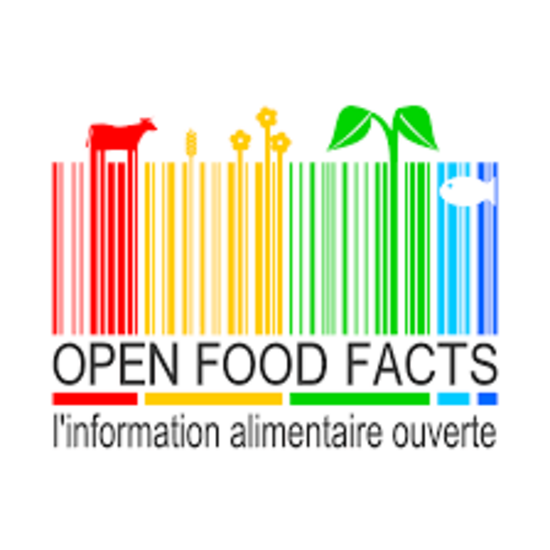 Download
Download
Open Food Facts
Editor's choice
- Open and collaborative database
- Over 1,5 million product references worldwide
- Exportable food lists
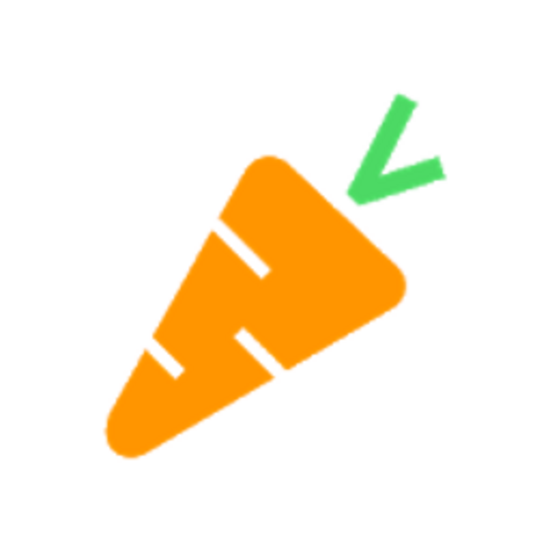 Download
Download
Yuka
The most popular
- Ergonomic interface
- Many alternatives offered
- Latest accessible scans
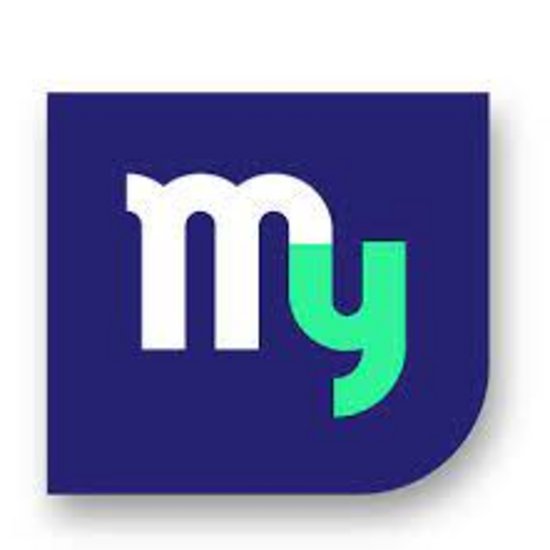 Download
Download
MyLabel
The challenger
- Product evaluated according to consumer values
- Varied and recognized partners (Ademe, GreenPeace, etc.)
- Monthly consumption report
We have tested the most widely used supermarket applications for you. Open Food Facts, Yuka, QuelProduit, Y'a Quelle Dedans, ScanUp, MyLabel… What differentiates all these applications available on Android? Are their data reliable? What part is left to interpretation? This article answers all these questions and helps you make the right choice.
Gone are the days when we put any product in our shopping carts! And yes, with the recent food scandals and the advent of organic, consumers have become a little more careful. The content of our plates contributes to our health, and eating healthy is important to many. Some even want to go further and want to contribute to a better world by promoting local producers or fair trade. Eating well is one thing, eating sustainably is another.
To help us choose the right foods, food scanning applications have grown tremendously in recent years. Today there is something for everyone: those who want to eat local, those who want to improve their health, those who do not want to fall into paranoia, those who want to have an impact on the environment, those who want to improve our company ... We offer you a complete tour of the question with this selection of six reputable applications. To your forks… uh… to your smartphones!
Summary
- How does a food scanning application work?
- Are the food data disseminated reliable?
- Open Food Facts, the benchmark
- Yuka, the most careful
- What's Inside, the most indulgent
- MyLabel, the most ecological
- WhichProduct, the most in favor of consumers
- ScanUp, the most creative
- Conclusion
How does a food scanning application work?
Yuka, MyLabel, ScanUp, QuelProduit, Y'a Quelle Dedans and of course, Open Food Facts… Food product scanning applications have invaded our Play Stores. The purpose of these tools? Enable users to read food labels better.
How does it work in practice? We do our shopping in the supermarket of our choice and we come across a product that makes us want. But how do you know if this product is not full of additives and unhealthy substances? How do you know if it's healthy, from a nutritional point of view? This is where food scanning tools come in. We unsheath our cell phone then we launch the application. We scan the barcode of the product and the verdict falls.
Nutritional information, environmental impact, controversial substances ... Everything you can know about the product scrolls before our astonished eyes, and once informed, we are free to take this food home or put it back on the shelf. .
While some applications have chosen to remain objective, others have chosen to give their interpretation and guide consumers in their choices. Many are based on the Nutri-Score, but some go further: Siga index, Eco-Score, etc.
Everything is done to support consumers' choices and help them eat better.
Are the food data disseminated reliable?
The majority of applications that allow us to decipher the labels of our foods draw on the Open Food Facts database. This collaborative and open tool has been around for nearly ten years: it brings together thousands of contributors in 200 countries.
Open Food Facts collaborates in particular with Public Health The objective? Allow greater availability of food data and promote the use of NutriScore. This colorful labeling now appears on many foods sold in supermarkets allows you to know at a glance the nutritional quality of the product.
If Open Food Facts is a benchmark and is recognized for its reliability, some applications have chosen to go further and work in a closed circuit. This is the case of Yuka, which privatized its database in 2018. It now uses feedback from its users as well as data from the start-up Alkemics, recently acquired by the American Salsify.
Same source for ScanUp, which also has a closed database and uses the Siga classification, which allows to know the level of food processing. UFC-Que Choisir, finally, is based on Open Food Facts but also enriches its proposal thanks to another database called Code Online Food.
Also, even between applications using Open Food Facts, the processing of data differs. The scanner is essential, but the functionalities vary, indeed, from one tool to another.
The analyzes also depend on the application. Some choose to focus on nutritional aspects, others highlight the environmental and even societal impact of food. Some interpret the results and offer their own evaluations, others choose to remain objective. Some are severe, others not at all. It is therefore up to the consumer to set his limits and to know how far he wishes to go in sorting his food.
Ready to learn all about the best apps for scanning food labels? Let's go !
Open Food Facts, the benchmark
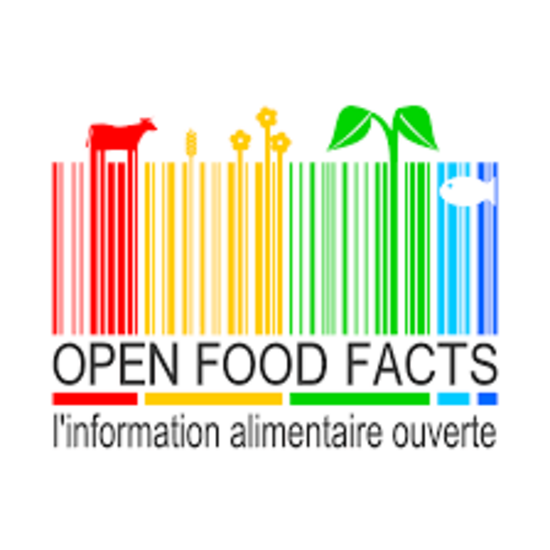 Télécharger
Open Food Facts
Télécharger
Open Food Facts
- Open and collaborative database
- Over 1,5 million product references worldwide
- Exportable food lists
Launched in 2012, Open Food Facts is recognized for its quality and reliability. It is the basis for many product scanning applications. This tool is based on numerous references and complete product sheets.
Launched in 2012, Open Food Facts is recognized for its quality and reliability. It is the basis for many product scanning applications. This tool is based on numerous references and complete product sheets.
Launched in 2012, the open source Open Food Facts project was created by Stéphane Gigandet and Pierre Slamich. The goal? Collaboratively index food products and make data available to everyone to better understand the composition of foods. The application of the same name provides access to this gigantic database, which contains more than 1,5 million references.
A reference if ever there is one, Open Food Facts is now used as a source for the vast majority of applications specializing in the scanning of food products: Yuka, MyLabel, What Product?, Etc. This is to say if the project is reliable. A pioneer in the field of decryption of food labels, Open Food Facts has earned a flattering nickname: the “Food Wikipedia”.
The mobile application allows you to consult this extremely comprehensive database in a few clicks. Rather simplistic in appearance, it is composed of a scan, a product comparator, a history and a section dedicated to creating lists.
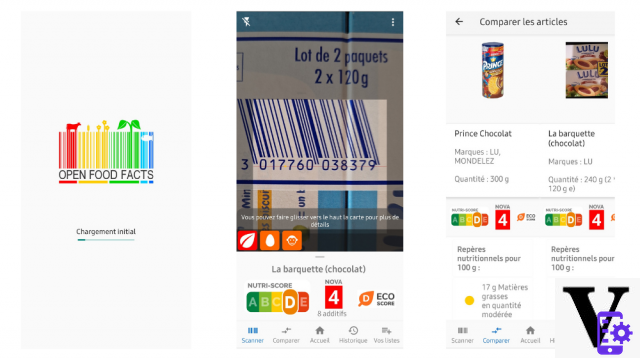 © Open Food Facts
© Open Food Facts
For each product scanned, Open Food Facts offers:
A summary mini-sheet, in which we can read: the Nutri-Score of the food, its Eco-Score (environmental impact) and its Nova index (super-processed foods). An alert lets you know if the food contains palm oil and if it is suitable for a vegetarian or vegan diet.
A detailed sheet, where you can find: nutritional information, the composition of the product, information on its environmental impact and a summary. If you want to know more, many links are available for further research on Wikipedia.
While it doesn't offer any alternatives, Open Food Facts has other cool features:
You can compare the products by scanning them one by one.
You can share the files, modify them or complete them with images.
Foods can be added to exportable lists.
Open Food Facts should especially appeal to those who appreciate completeness and thoroughness and do not dwell too much on the look of an application.
Yuka, the most careful
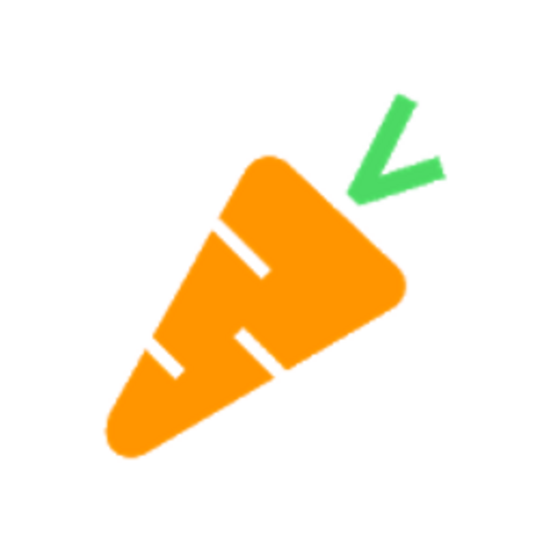 Download Yuka
Download Yuka
- Ergonomic interface
- Many alternatives offered
- Latest accessible scans
Known for her uncompromising reviews, Yuka helps consumers decipher food labels. This well-designed application with its own evaluation system has attracted more than 25 million users.
Known for her uncompromising reviews, Yuka helps consumers decipher food labels. This well-designed application with its own evaluation system has attracted more than 25 million users.
Launched in 2017, this freemium tool is completely independent and evaluates food products, but also cosmetics. It includes a rating system of its own, which ranges from A to E (the latter is also often questioned). For a food product, Yuka evaluates three criteria:
The nutritional quality of the food,
The presence or absence of additives,
The presence of an organic label or not.
The first criterion is valid for 60% of the mark, the second is worth 30% of the mark and the last, 10%. Yuka is known for her rather severe notations: she applies, in fact, a principle of precaution. If a food contains an ingredient carrying a risk, even not proven, the score is reduced.
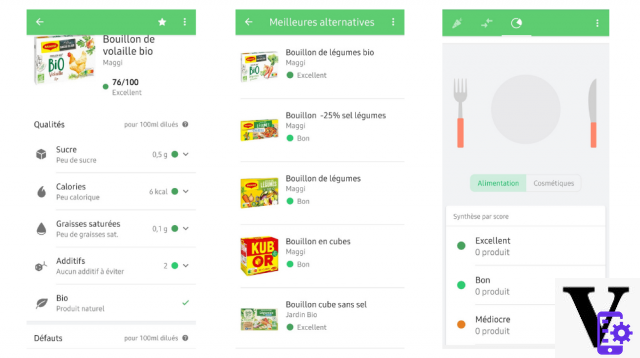 © Yuka
© Yuka
The application was first based on the open database Open Food Facts. However, it now operates as a closed tool: more than 1,5 million food products are listed there! Yuka, however, continues to feed the Open Food Facts database. Its sources are numerous:
Opinions from organizations such as ANSES, EFSA, IARC, ANSM, CNRS, etc.
Studies of associations such as UFC-Que Choisir
Various scientific studies and databases
Yuka wishes, as stated by her co-founder, to put pressure on the agri-food sector in order to contribute to a long-term improvement of food and its mode of manufacture. And it works: brands like Intermarché have started to change the composition of some of their products to obtain a better score on the application.
One of the great strengths of this tool is also to offer healthy alternatives to unsavory products. It is also possible to consult its latest scans to know the distribution of the products consumed.
What's Inside, the most indulgent
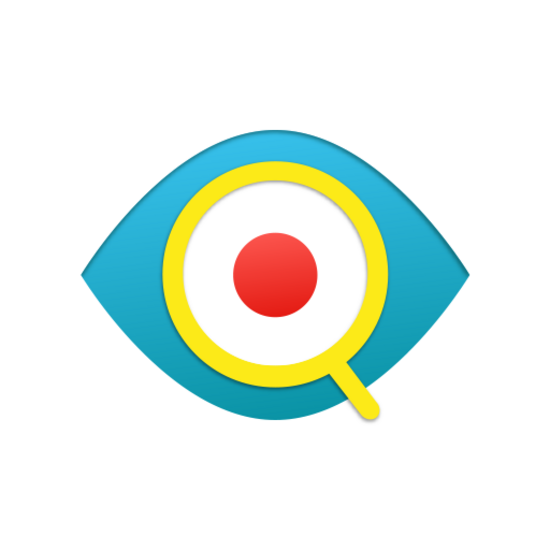 Download What's Inside
Download What's Inside
- Customizable preferences
- Objective product sheets
Launched in 2018 by U Store, Y'A Quelle Dedans is a food scanning application known for its indulgence. It still aspires to promote local agriculture as well as employment in our country and contribute to better protection of the planet's resources.
Launched in 2018 by U Store, Y'A Quelle Dedans is a food scanning application known for its indulgence. It still aspires to promote local agriculture as well as employment in our country and contribute to better protection of the planet's resources.
Y'a Quelle Dedans is a free application launched by Supermarkets U in 2018. It uses the Open Food Facts database and recognizes more than 374 references. All you have to do is scan a barcode to access the food product sheet. The latter presents the information objectively and answers several questions:
What are the ingredients in the product?
Are there any additives? (for each of them, it is possible to click on a link to obtain more information)
What are the nutritional values of the food?
In which other stores can you find this product?
Developed by Niji, Y'a Quelle Dedans can be used without a connection and has a good user experience: it is fluid, fast and easy to use. Four sections are present: "Search", "Favorites" "Scan" and "Preferences".
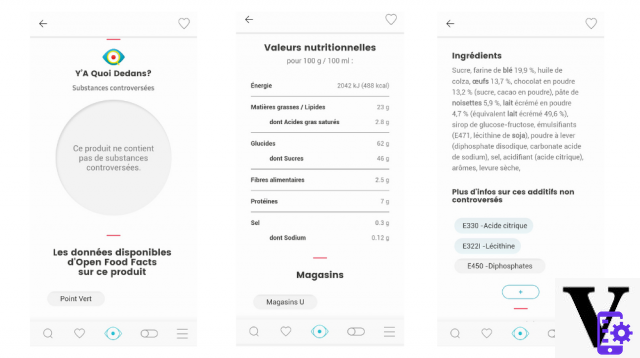 © U Stores
© U Stores
The focus is on controversial substances. Y'a Quelle Dedans also allows you to choose the elements you do not want to find in your food upstream. It is also possible to indicate whether you prefer organic products.
Note that this application is the only one in this comparison that is not independent. It compensates for this position by offering objective files where there is no room for interpretation. No alternative is offered to the products and it is based on commitments such as supporting local agriculture and employment in our country, improving the products sold in U chains and protecting land and aquatic resources. .
Y'a Quelle Dedans is however less severe than its competitors. Also, where most of her sisters, Yuka in the lead, warn about the composition of certain foods by applying the precautionary principle, Y'a Quelle Inside remains behind. Even some products notoriously too fatty, too sweet or too salty seem to find favor in his eyes.
A guilt-free app, ideal for people who don't want to see evil everywhere.
MyLabel, the most ecological
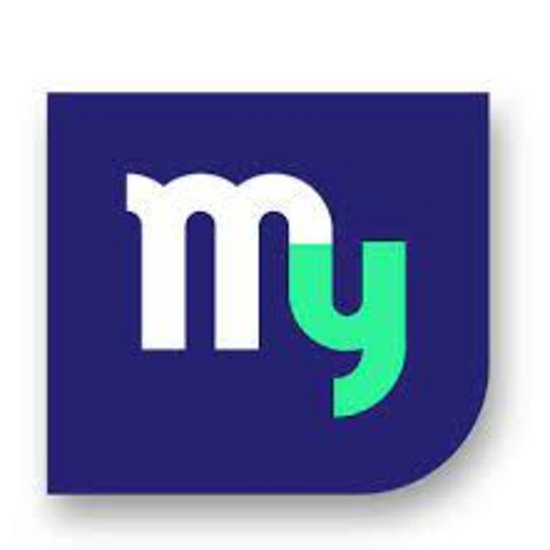 Download MyLabel
Download MyLabel
- Product evaluated according to consumer values
- Varied and recognized partners (Ademe, GreenPeace, etc.)
- Monthly consumption report
Indeed, MyLabel asks its users to define their priorities. There are about twenty choices:
Health-related criteria (allergens, pesticides, GMOs, etc.)
Criteria linked to society (fair work, preservation of the local population, fight against child labor or discrimination, etc.)
Environmental criteria (fight against pollution, deforestation, etc.)
The evaluations available come from various and recognized partners: the Open Food Facts database, Ademe, the consumer institute, but also associations such as Greenpeace.
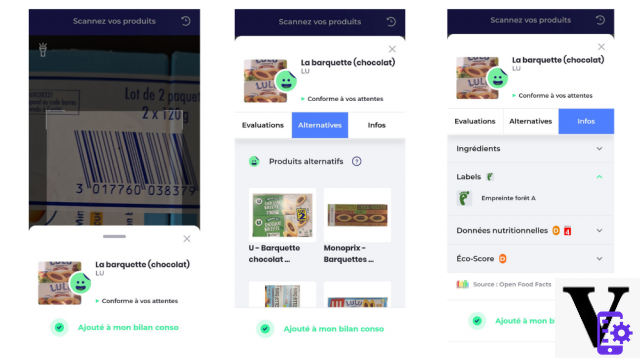 © MyLabel
© MyLabel
MyLabel is organized in three parts: a scan, a monthly assessment of the user's consumption and the profile parameters (in which we can indicate and update our values).
The scan starts as soon as it is placed above a barcode. If the product is found (and this is generally the case, given that the database includes more than 800 references), MyLabel opens a detailed file, in which we find in particular:
An assessment of the suitability of consumer values, highlighted by a system of colored smileys (green, yellow or red)
The ingredients constituting the product and the nutritional values
The food's Eco-Score as well as the labels it may have obtained
MyLabel is the perfect app for those who want to consume more fairly. Fluid and easy to use, it will appeal to people who like to learn with ease. Its great customization possibilities are a considerable advantage and it is possible to quickly decipher the labels of the different scanned food products.
WhichProduct, the most in favor of consumers
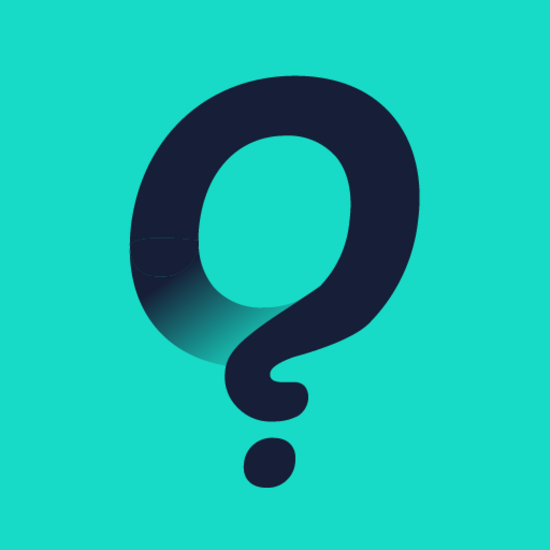 Download Which Product?
Download Which Product?
- Expertise of the UFC-Que Choisir
- Harmful substances sorted by user type
- Easy to understand risk assessment
Benefiting from the experience of the UFC-Que Choisir consumer association, Quel Produit is a scanning application for food, cosmetic and household products. Complete, it allows you to scan product barcodes and find out if they are good for your health.
Benefiting from the experience of the UFC-Que Choisir consumer association, Quel Produit is a scanning application for food, cosmetic and household products. Complete, it allows you to scan product barcodes and find out if they are good for your health.
QuelProduit was created to follow on from QuelCosmetique, a mobile application dating from 2018. Using in part, like many of its competitors, the Open Food Facts database, QuelProduit is in fact a three-in-one service. It is indeed possible to decipher the labels of food, cosmetic, but also household references.
The application has a sober appearance and has only two components:
A scan section
A list of favorites
A search bar allows you to type in product names and search for them in the database. If the product is not present in the 372 references listed, the consumer can still create and offer a product sheet.
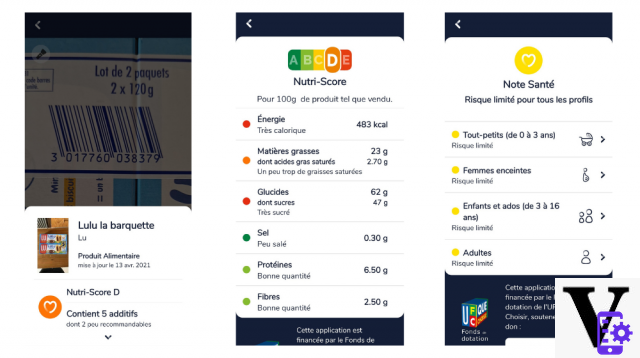 © UFC-Que Choisir
© UFC-Que Choisir
QuelProduit puts health at the heart of its concerns and is based on a simple rating system. The application assesses, in fact, the risks of consuming or using a product. To do this, it relies on the Nutri-Score (for food products) and supplements the information through evaluations and research carried out by engineers from the UFC-Que Choisir association.
Once the product has been scanned, the application gives us a colored rating (from green to red, with five levels of risk) and allows us to consult the detailed sheet of the reference. You can see nutritional information, harmful substances and their level of risk by type of person (toddlers, children, adolescents, adults, pregnant women). What if a product is risky for health? It is possible to draw from a long list of alternatives!
QuelProduit has the experience and know-how of the UFC-Que Choisir association and it shows. This app inspires confidence and the fact that it is a three-in-one tool is a real plus.
ScanUp, the most creative
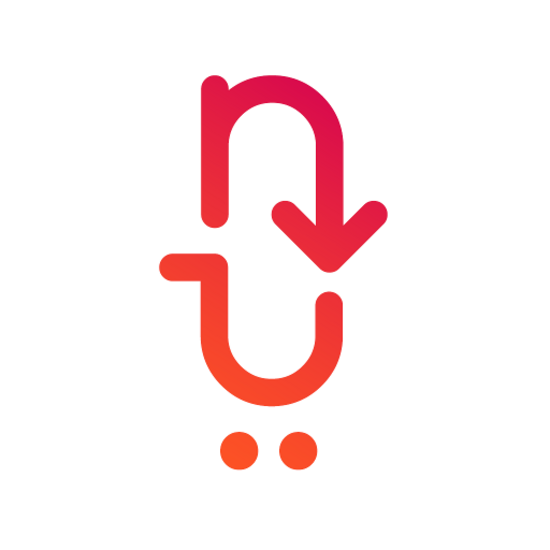 Download ScanUp
Download ScanUp
- Global vision (health, ecology)
- Tool for co-creation of products with manufacturers
- Nutritional assessment of shopping lists
Launched in 2017, ScanUp is based on the NutriScore, the Eco-Score and the Siga index to judge whether a food is good or not for health. This complete and handy tool allows you to quickly scan your shopping and decipher its content.
Launched in 2017, ScanUp is based on the NutriScore, the Eco-Score and the Siga index to judge whether a food is good or not for health. This complete and handy tool allows you to quickly scan your shopping and decipher its content.
Launched in 2017, ScanUp is an application that offers a global view of evaluated foods. For each product scanned, we have access to a summary sheet: three gauges indicate the level of processing of the product, its nutritional qualities and its impact on the planet. This tool is based on several elements:
The index Follow
L’Eco-Score
the Nutri-Score
It is possible to go further by going to a detailed sheet, in which we find in particular the composition of the product, as well as the various additives used. Unlike applications like Yuka, ScanUp does not offer a rating of its own and prefers to remain neutral. It thus gives all the elements to get an idea about the food without however explaining them.
The database used by Scan Up is closed and updated in real time. The application teams carry out several types of checks to ensure the reliability of the data (automated or manual checks, image processing, etc.).
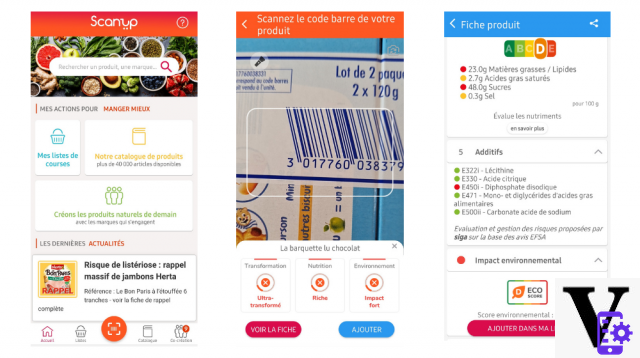 © Scan'Up
© Scan'Up
ScanUp has a fairly extensive interface: its reception is, for example, equipped with a search bar, a link to the various ancillary tools (catalog, shopping list writing, co-creation of products with manufacturers) and a very practical “news” section (it provides information in particular on product recalls or food ratings).
Its categorized catalog is provided, with more than 600 references. Foods that have received a Siga medal are highlighted, which is good, and less processed foods are also well placed. This is what makes ScanUp so interesting: the application is full of great ideas. For example :
It is possible to ask the application to evaluate the content of a shopping list and to give a nutritional assessment,
It is possible to co-create products by voting for the characteristics that are important to us.
Conclusion
It is important to clearly define your needs and values before choosing an application to decipher your food labels. All of these tools are packed with valuable nutritional information, but their treatment differs from one to another.
People who are looking for a comprehensive tool and like to take the time to research will be inclined to Open Food Facts. Those who are short on time and want expert, straightforward advice on their products will appreciate Which product ou Yuka. The alternatives offered by these tools are real pluses.
Which product has the advantage of making a difference: certain substances are, in fact, harmful for certain categories of people, but not for others and the application is the only one to make this distinction.
ScanUp will appeal to consumers who seek a more global vision and like to get their hands dirty: the many participatory product creation campaigns are rewarding and allow them to ask the right questions. Those who don't like to mess around will appreciate the simplicity of the app. What's Inside. At last, MyLabel has everything you need to appeal to the most committed people, especially in terms of ecology.
However, using any of these tools helps a lot in managing your diet. While there are still areas for improvement, product scanning applications are serious enough to earn the trust of users. Their influence on industrialists is also beginning to be felt, and that is a good thing.
The other advantage? Users are no longer passive: they too can make a contribution and help improve food databases. And yes, being a consumer in our connected age is also becoming an actor, and we can all contribute to ensuring that the whole world, and not just our family, eats better!


























